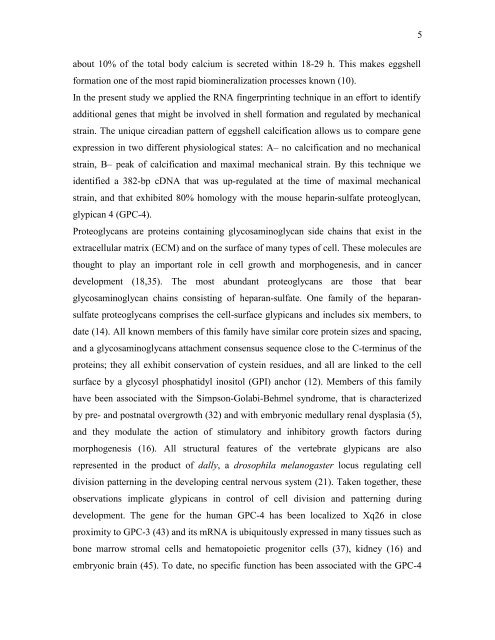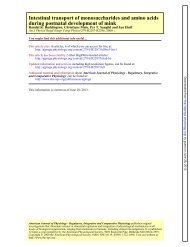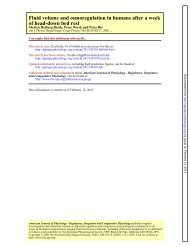Mechanical strain regulation of the Chicken glypican-4 gene ...
Mechanical strain regulation of the Chicken glypican-4 gene ...
Mechanical strain regulation of the Chicken glypican-4 gene ...
You also want an ePaper? Increase the reach of your titles
YUMPU automatically turns print PDFs into web optimized ePapers that Google loves.
about 10% <strong>of</strong> <strong>the</strong> total body calcium is secreted within 18-29 h. This makes eggshell<br />
formation one <strong>of</strong> <strong>the</strong> most rapid biomineralization processes known (10).<br />
In <strong>the</strong> present study we applied <strong>the</strong> RNA fingerprinting technique in an effort to identify<br />
additional <strong>gene</strong>s that might be involved in shell formation and regulated by mechanical<br />
<strong>strain</strong>. The unique circadian pattern <strong>of</strong> eggshell calcification allows us to compare <strong>gene</strong><br />
expression in two different physiological states: A– no calcification and no mechanical<br />
<strong>strain</strong>, B– peak <strong>of</strong> calcification and maximal mechanical <strong>strain</strong>. By this technique we<br />
identified a 382-bp cDNA that was up-regulated at <strong>the</strong> time <strong>of</strong> maximal mechanical<br />
<strong>strain</strong>, and that exhibited 80% homology with <strong>the</strong> mouse heparin-sulfate proteoglycan,<br />
<strong>glypican</strong> 4 (GPC-4).<br />
Proteoglycans are proteins containing glycosaminoglycan side chains that exist in <strong>the</strong><br />
extracellular matrix (ECM) and on <strong>the</strong> surface <strong>of</strong> many types <strong>of</strong> cell. These molecules are<br />
thought to play an important role in cell growth and morpho<strong>gene</strong>sis, and in cancer<br />
development (18,35). The most abundant proteoglycans are those that bear<br />
glycosaminoglycan chains consisting <strong>of</strong> heparan-sulfate. One family <strong>of</strong> <strong>the</strong> heparansulfate<br />
proteoglycans comprises <strong>the</strong> cell-surface <strong>glypican</strong>s and includes six members, to<br />
date (14). All known members <strong>of</strong> this family have similar core protein sizes and spacing,<br />
and a glycosaminoglycans attachment consensus sequence close to <strong>the</strong> C-terminus <strong>of</strong> <strong>the</strong><br />
proteins; <strong>the</strong>y all exhibit conservation <strong>of</strong> cystein residues, and all are linked to <strong>the</strong> cell<br />
surface by a glycosyl phosphatidyl inositol (GPI) anchor (12). Members <strong>of</strong> this family<br />
have been associated with <strong>the</strong> Simpson-Golabi-Behmel syndrome, that is characterized<br />
by pre- and postnatal overgrowth (32) and with embryonic medullary renal dysplasia (5),<br />
and <strong>the</strong>y modulate <strong>the</strong> action <strong>of</strong> stimulatory and inhibitory growth factors during<br />
morpho<strong>gene</strong>sis (16). All structural features <strong>of</strong> <strong>the</strong> vertebrate <strong>glypican</strong>s are also<br />
represented in <strong>the</strong> product <strong>of</strong> dally, a drosophila melanogaster locus regulating cell<br />
division patterning in <strong>the</strong> developing central nervous system (21). Taken toge<strong>the</strong>r, <strong>the</strong>se<br />
observations implicate <strong>glypican</strong>s in control <strong>of</strong> cell division and patterning during<br />
development. The <strong>gene</strong> for <strong>the</strong> human GPC-4 has been localized to Xq26 in close<br />
proximity to GPC-3 (43) and its mRNA is ubiquitously expressed in many tissues such as<br />
bone marrow stromal cells and hematopoietic progenitor cells (37), kidney (16) and<br />
embryonic brain (45). To date, no specific function has been associated with <strong>the</strong> GPC-4<br />
5







